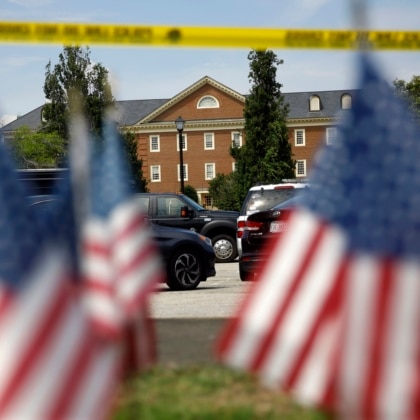

American flags, part of a makeshift memorial, stand near the site of a 2019 shooting in Virginia Beach, Va. (AP)
VOA Special Report
Workplace shootings
Workplaces were the most common sites for mass shootings, at 31%
Mass shootings (1966 - February 2020)
The first workplace mass shooting of the modern era took place in 1967 at a paper mill in Lock Haven, Pennsylvania.
Mass shootings are defined by the Congressional Research Service as four or more victims.
By the 1990s, the number of workplace shootings had increased significantly, to 16. During that decade, shootings occurred at a Xerox office building in Honolulu, Hawaii, a Radisson Hotel in Tampa, Florida, and two day trading firms in Atlanta, Georgia.
One of the more common locations for a workplace shooting was a U.S. post office. The first mass shooting there took place in 1986, when an employee in Edmond, Oklahoma, shot 20 co-workers, killing 14 of them. In 1991, five workers were killed at a post office in Royal Oak, Michigan, by a co-worker who had been fired.
On May 6, 1993, two post office shootings occurred a few hours apart, in Dearborn, Michigan, and Dana Point, California. Though these incidents did not fit the Congressional Research Service’s definition of a mass shooting, they inspired a new slang for workplace shootings. By the end of the year, “going postal” had entered the public’s vocabulary.
Military facilities have also become a common site of workplace shootings. In 1994, a mass shooting at Fairchild Air Force Base in Washington state killed four people. A shooting at Fort Hood, near Killeen, Texas, in 2009 left 13 unarmed soldiers and civilians dead. In 2013, an attack at the Navy Yard in Washington, D.C., killed 12.
Workplace mass shooting locations Fatalities and workplace mass shootings
Circles scaled according to the number of fatalities.
Jillian Peterson, Ph.D., and James Densley, Ph.D., built a new database of mass shooters that they hope will inform future research and policy decisions about how to effectively prevent and respond to mass shootings.
For their study, they used the Congressional Research Service’s definition of a mass shooting:
“a multiple homicide incident in which four or more victims are murdered with firearms — not including the offender(s) — within one event, and at least some of the murders occurred in a public location or locations in close geographical proximity (e.g., a workplace, school, restaurant, or other public settings), and the murders are not attributable to any other underlying criminal activity or commonplace circumstance (armed robbery, criminal competition, insurance fraud, argument, or romantic triangle).”
About the data
All shooters have either been charged, convicted or killed at the scene.
The team collected more than 100 pieces of information on each of 172 mass shooters, resulting in The Violence Project Database of Mass Shootings in the United States, 1966 - February 2020.
They compiled details on hundreds of factors, including age, race, gender, nationality, sexual orientation, religion, education, relationship status, number of children, employment type and status, military service and branch, criminal, violence and abuse history, gang and terrorist affiliation, bullying, home environment and trauma.
What emerged were fleshed-out profiles and motivations of individual shooters, whose crimes can potentially influence current, and future policy and prevention.
Workplace shootings (1966 - February 2020)
While there is no single profile of a mass shooter, there are several similar characteristics of shooters who commit crimes where they work.
According to The Violence Project database, a workplace shooter was a male in his 40s of any race. He was a blue-collar worker and had trouble at work. He used handguns and assault rifles that he legally owned.
Almost all workplace shooters have employment troubles (77%). While many are motivated to carry out their shooting at least in part by anger over workplace issues, some recent high-profile shootings have been carried out in the name of terrorism, including the attacks at a San Bernardino County, California, office party in 2015, and the Fort Hood, Texas, military base in 2009.
Nearly all workplace shooters showed signs of crisis (75%), or a marked change in behavior, often triggered by a job dismissal. Such signs include failing to comply with directives, exaggerated emotional responses, and increased interest in violence or weapons.
Sixty percent of workplace shooters had mental health concerns; 23% had been abused as children or witnessed abuse; and 49% had carried out their crime with weapons they had legally purchased.
Forty percent of workplace shooters were white, while 51% were minorities. The average age of workplace shooters was 38.5, much higher than shooters who carried out killings at schools (18) or in restaurants or bars (33).